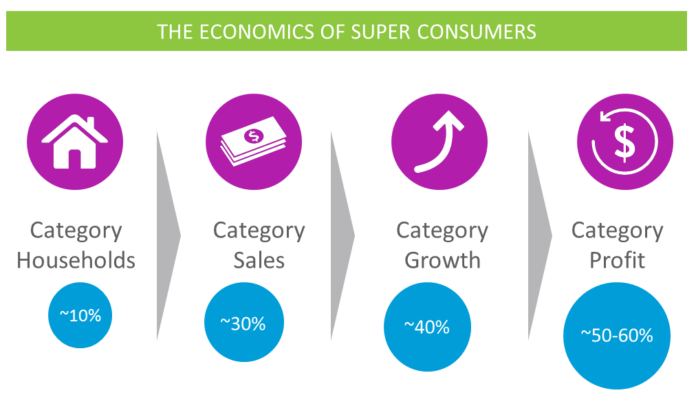
According to the National Retail Federation, the annual holiday season makes up an average of 20 percent of annual sales for retailers. It is critical for businesses to make sure they are catering to their market’s demands, particularly to their “superconsumers,” or consumers who buy a lot and care a lot about their category.
A new book by Eddie Yoon called Superconsumers: A Simple, Speedy, and Sustainable Path to Superior Growth, published by the Harvard Business School Press, explores these superconsumers who make up the top 10 percent of consumers yet drive 30-70 percent of category sales, and they’re usually willing to spend considerably more than the average consumer.
In this article, we explore why superconsumers are important, how small businesses can identify their superconsumers to propel growth year-round, and important lessons learned from listening to superconsumers.
What inspired you to write this book?
Over the two decades of growth strategy work, it seems like the world has gotten more complex, competition has become faster and fiercer and consumers are more diverse than ever. It’s like growing your business went from chess by mail to speed cheese.
I felt like the best way to help most of my clients—both at large companies and at startups—was to make things simpler. Superconsumers is at its core an extremely simple idea to explain and use. “Supers” are consumers who buy a lot and care a lot about a category. That’s it.
A simple idea is easy to keep in your head, so when you have to make a quick, critical decision without enough information, you can make a well-educated bet.
A simple idea can help you form hypotheses to be proactive about managing complexity. It can make big data usable and not overwhelming, because you know what you are looking for.
A simple idea is easy to align an organization around at all levels and all functions. And that alignment is often more important than your growth strategy per se.
I felt like it was my obligation to help as many business leaders as I can to simplify how to grow their business.
Why are “super-consumers” important?
Superconsumers goes back to 1896 with Vilfredo Pareto about the Pareto principle, or commonly known as the 80/20 rule.
My old firm, The Cambridge Group, was part of Nielsen. There I had access to a ton of big data that validated that the top 10 percent of consumers drive 30-70 percent of category sales, even more category profit and 100 percent of category insights.
Supers are economically important for sure, but it’s their insights that are even more valuable. They weren’t born supers, but they evolved that way over time. That superconsumers origin story holds the keys to not only drive growth, but significantly grow the category or even create a new category, which is the far superior form of growth strategy.
How can small businesses, local companies, and start-ups identify their industry’s “super-consumers”?
There are three ways to do this
- Look amongst your friends, family and co-workers. Many business leaders have supers walking amongst them and they don’t realize them. A pork company I served had a bacon superconsumers who worked in finance. He ate 3 lbs of bacon per week (and yet was thin as a rail) and gave awesome advice about marketing and innovation….areas beyond his work expertise, but he had a wealth of info as a superconsumer.
- Look in your data. I hate the words national average, because they smooth out all the nooks and crannies of data. The spikes and valleys in your data is really what is the most interesting. Is there a local city/market where per capita spending of your category or business is super high? There are superconsumers there. Are there specific brands or products that are taking off? Those are probably driven by superconsumers. Variance in your data is your best friend.
- Look in digital. The average consumer doesn’t post photos on Facebook or tweet about regular products they don’t care about. If someone is on social media talking about a basic product like a pen, the odds are very high they are a superconsumer. How supers spend their time online is as telling as how much money they spend.
What can these companies do to reach out to these “super-consumers” to propel growth?
Same as above. Look amongst your friends, family and co-workers and start a conversation. Look in your data for hot spots, then go talk to the consumers there. Connect with people on social media posting about your category, both positive and negative. Remember that anger is actually love in motion, it’s not the opposite of love (indifference is).
They are eager to talk about the category they love.
What are some important lessons that can be learned by listening to “super-consumers”?
Find their origin story. Just like Marvel has made a ton of money talking about super hero origin stories, superconsumer stories have tremendous value. How did they enter the category? How did they transition from average to super? When and why did they start evangelizing the category?
One more nugget. I found in the big data that a superconsumer of one category is a super of nine others. Figure out what those adjacent categories are. Some are obvious, others are not! But all of it gives you a full picture of who these people are, why they care and how you can help them on their journey of passion.
In your studies for your book, what are some examples of companies utilizing “super-consumers” to their benefit or ignoring to their detriment?
An office products company embraced this idea of superconsumers. They realized they had stapler superconsumers, who would go through a box of 5,000 staples like nothing. And for them, anti-jamming was a huge benefit. And given that, that the best staplers were heavy duty staplers and electric staplers.
They talked to all three office supply stores at the time about their superconsumers and a strategy to re-invent the stapler shelf to appeal to supers, with heavy duty staplers and electric staplers at eye level. Two of the three said, “Great!” We had no idea these folks existed. Their stapler business went up 19 percent in nine months.
The third office retailer said, “This is crazy. No thank you, we’ll focus our shelf on our cheap private label products.” Their business went down nine percent in the same nine month period!
Shat advice can you give to consumers to consume wisely?
I recently wrote an article in inc.com about the goldmines and land mines of the holiday season. In particular, the risk of costly store returns is huge. The core reason why we return gives is that we are collectively bad at gift giving.
My advice is to first give gifts not out of need but want. Think about what categories your friends/family members are super in, and you’ll give a great gift they love that they’ll actually use and not return or re-gift!
Second, be self-reflective of what you are a superconsumer in. Don’t be shy and tell your family/friends so that they can buy you better gifts. You’ll both be happier for it, as will retailers and manufacturers.













